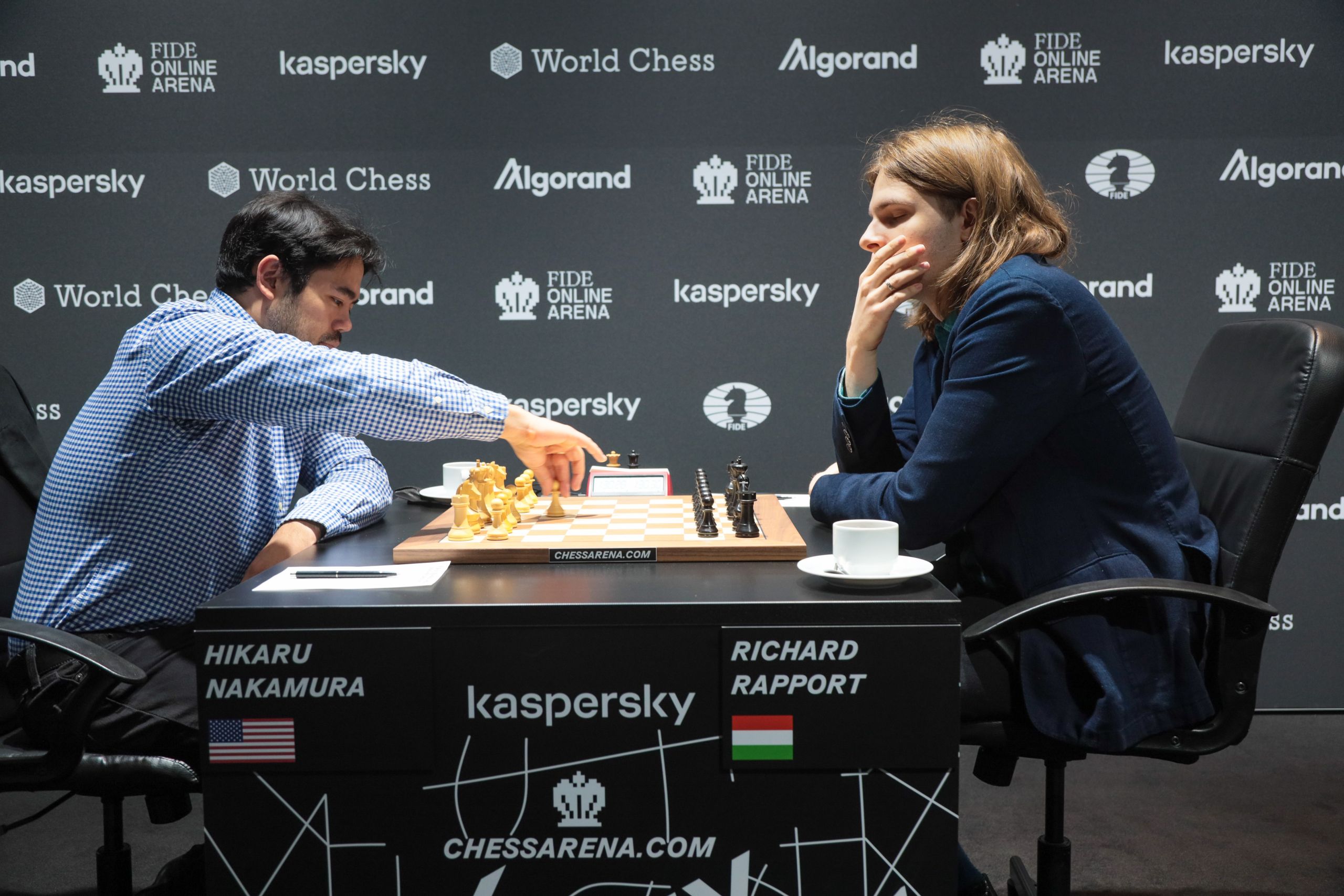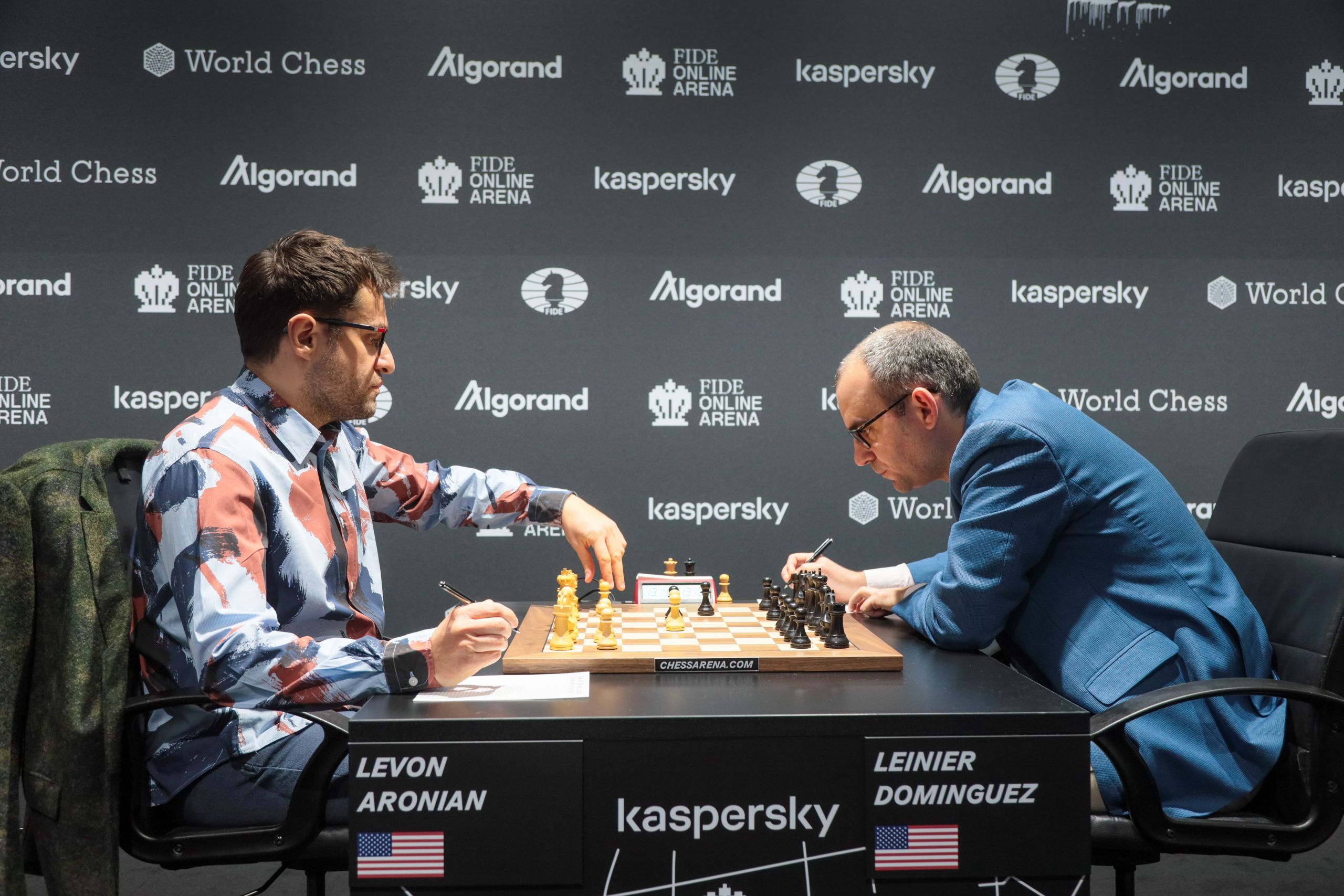Aronian and Nakamura pull ahead
The semifinals began punctually with the ceremonial first move by German cabaret artist Matthias Deutschmann on board one. After the customary greetings, Nakamura indicated his intention of opening the game with 1.d4 and Deutschmann firmly moved the d-pawn two steps forward.

The rules and regulations of the 2022 FIDE Grand Prix determine a 24.000-euro prize for the winner while the runner-up receives 18.000 euros. Both semifinalists receive a check for 12.000 euros. In addition to the prize money, the winner of the Berlin leg gets 13 Grand Prix points, quite a few more than the 7 received by the semifinalists. Winning here – or at least advancing to the final – is definitely a huge step towards the final goal: the two spots that qualify to the Candidates.
Currently USA Olympic teammates, Levon Aronian and Leinier Dominguez Perez have played at the highest level for more than fifteen years. According to my database their first encounter was in Beersheba (Israel) in the 2005 World Team Championship, in the match between Cuba and Armenia.
That game ended in a relatively quick draw and, since then, they have faced each other 59 times, excluding online events, with a clear advantage on the scoreboard for the former Armenian player: 37,5 – 22,5. However, if we factor out the OTB rapid and blitz games, Aronian is barely leading by 4-3.
Having won his preliminary group a round before the end, Aronian has essentially enjoyed two rest days, while Dominguez returned to the playing venue yesterday to eliminate Wesley So. But these things can work both ways – you can never know if extra games and effort favours a player or makes him even more tired.
Although according to rating Richard Rapport would be considered favorite, things are not so clear if we go over their history together. Excluding blitz and rapid events, Nakamura has scored 2.5 points in the 3 games where they have played each other. Also, the American qualified to the semifinals with no need of a tiebreak: one extra rest and preparation day for him
Finally, every classical game of this tournament has an added importance for Nakamura: he has already confirmed here that he will only play for USA in the Moscow Olympiad if he is one of the four main boards, never as a reserve. Currently he is in fifth place behind Caruana (2792), So (2772), Aronian (2772) and Dominguez (2752) so he still has some ground to cover
Board 1: GM Hikaru Nakamura (USA 2736) – GM Richard Rapport (Hungary 2779)
Rapport went for the Queen’s Gambit declined for this very important game. In the opening, Nakamura kept looking at the games monitor and checking out the other board: obviously he was also interested in the development of Aronian’s choice of line.
For many moves the position was identical to Kasparov-Smyslov from the 1988 USSR Chess Championship, until Nakamura diverged with 15.Kb1 (15.Nf4 was played in that game and a draw was agreed son after). Rapport kept the balance with precise defensive moves until Nakamura initiated some interesting tactics on the kingside with 23.Bxg6!?, giving up the exchange but securing an outside passed h-pawn.

Low on time, Rapport couldn’t find the best defence and soon he decided to return the material. However, although only a pawn down the rook ending was very difficult to defend due to Nakamura’s active king and passed center pawns: with a few accurate moves, Nakamura wrapped up the game.
In conversation with IM Michael Rahal, Press Officer for the event, Nakamura felt that he had played well, but complicated things unnecessarily: “Of course, it should be winning but it’s very tricky: with one bad move I can lose, Black has two pawns as well, going down the a and b files. I was quite mad at myself because at the beginning I think I had an easier win. But it is what it is, and you just try to play the best moves even after you make a mistake”.
Rapport recognized that giving back the exchange was a mistake: “I didn’t realize that 15 moves ahead is would be so forcing”.
Board 2: GM Levon Aronian (USA 2772) – GM Leinier Dominguez (USA 2752)
The game between Aronian and Dominguez was a treat to spectators, full of twists and turns, an absolute rollercoaster. Aronian’s preparation for the game was unparalleled: he played the opening so fast that it seemed that he expected this line to appear on the board.
“You can never guarantee you will get certain positions on the board but since Leinier employs this opening, which is very interesting for Black, I thought there was a probability that this might happen. It’s a difficult position for humans to play as it requires immense pressure and I had the feeling that after a difficult tiebreak it was my best chance to surprise Lenier” were Aronian’s impressions after the game.

The opening, a Queen’s Gambit accepted, is one of Leinier’s specialties, but Aronian came with a very aggressive idea that wins the exchange (a rook for a minor piece) but leaves him behind in development.
“Dominguez has less than an hour on his clock, which makes me question the depth of his preparation. He was the one to pick this very sharp line and yet he is thinking too much” was online commentator Evgenij Miroshnichenko’s take on Leinier’s choice of variation.
Low on time, Dominguez was unable to keep generating threats to compensate his material deficit and at some point Aronian was able to force the exchange of queen’s, leading to a easily winning ending.
In the postgame press conference, Leinier understood that the game hadn’t gone his way: “It’s obviously a very difficult position to play in practice. I probably took too much time thinking about the different possibilities. Tactically I didn’t see how to capture on d4 with my bishop so I went for this idea with …Ne5 and …Nc6 but I missed the strength of 23.b3!. All in all, a difficult game: I had some interesting chances but the way I played it wasn’t good”.
About the Tournament
The three-tournament Grand Prix series which will unfold from February to April features twenty-four of the world’s best Grandmasters, who will compete in two of the three events. In order to make the series more exciting and reduce the percentage of draws, FIDE and World Chess have changed the format.
This innovative approach is new for the chess world but very similar to the Super League: the first stage has four pools of four players and the winner of each pool advances to the semifinals and then to the final.
The venue of the first leg is the World Chess Club Berlin, located at the City Centre on Unter den Linden, 26-30 and the games will be played from February 4th-17th every afternoon at 3 pm. Along with the two qualification spots for the Candidates, the event has a 150.000 euros prize fund, 20.000 euros more than the 2019 series.
All the games will be broadcasted live with expert commentary in three languages here. More information and the full schedule can also be found on the worldchess.com website. Full pairings can be found here.
Due to COVID restrictions currently in place, only a limited number of tickets are available. Please note that the 2G+ rule applies to the event, which means that visiting the venue is only possible for those who either have a complete vaccination with EU-certified vaccine or proof of recovery and can additionally present a booster dose certificate or a negative test result.
Leading companies supporting the FIDE Grand Prix Series 2022 include:
Kaspersky as the Official Cybersecurity Partner
;
Algorand as the Official Blockchain Partner
;
Prytek as the Technology Transfer Partner
;
FIDE Online Arena as the Official Partner.


